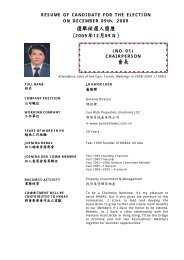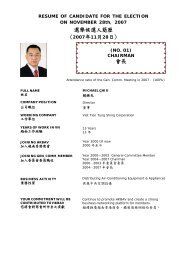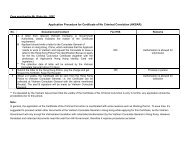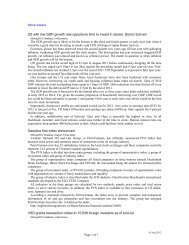31 Aug 2012 Intellasia Finance Vietnam - Hong Kong Business ...
31 Aug 2012 Intellasia Finance Vietnam - Hong Kong Business ...
31 Aug 2012 Intellasia Finance Vietnam - Hong Kong Business ...
You also want an ePaper? Increase the reach of your titles
YUMPU automatically turns print PDFs into web optimized ePapers that Google loves.
FINANCE<br />
<strong>Vietnam</strong> finance & business <strong>31</strong> <strong>Aug</strong>ust <strong>2012</strong><br />
<strong>Business</strong>es Ask For<br />
Delay On Salary<br />
Increases<br />
"<strong>Vietnam</strong>ese exporters tend to sell their products at low prices to attract buyers, but get<br />
themselves into trouble with US anti-dumping lawsuits."<br />
The statement was made on <strong>Aug</strong>ust 28, at a conference for trade promotion with the<br />
US, held in Hanoi. He added that domestic exporters should focus on quality and pay<br />
more attention to quality and more environmentally-friendly products if they wish to<br />
create sustainable trade with the United States.<br />
Khien said that from 50-60 percent of <strong>Vietnam</strong>'s footwear products exported to the US<br />
are only half-finished because <strong>Vietnam</strong>ese firms lack design expertise. Most <strong>Vietnam</strong>ese<br />
companies receive design models and materials from their US partners, working<br />
as subcontractors for firms from <strong>Hong</strong> <strong>Kong</strong>, Taiwan or South Korea, instead of being<br />
direct contractors for American firms.<br />
The larger <strong>Vietnam</strong>ese apparel firms have the capacity to act as a bridge for small local<br />
exporters to help them reduce overhead, he suggested.<br />
Opportunities pose challenges<br />
The US, home to the largest overseas <strong>Vietnam</strong>ese community in the world, with<br />
around 1.5 million, is a significant market for <strong>Vietnam</strong>ese goods. The US market is also<br />
widely considered to be less demanding than that of Japan or Europe. <strong>Vietnam</strong>'s entry<br />
to the WTO, along with the removal of Permanent Normal Trade Relations (PNTR)<br />
and garment and textile export quotas have paved the way to increased exports to the<br />
US.<br />
However, <strong>Vietnam</strong>ese exporters still face many challenges for entry of their goods to<br />
the US market. Currently China accounts for about 75 percent of the total footwear imported<br />
to the United States. For other apparel, China accounts for 33 percent, for electronics,<br />
32 percent, seafood, 18 percent and plastics, 25 percent.<br />
China is not <strong>Vietnam</strong>'s only major competitor, however. Indonesia and Bangladesh are<br />
also competing for exports. Another obstacle is that there is only one direct shipping<br />
rout linking <strong>Vietnam</strong> with the US. The long distance adds to high shipping fees, along<br />
with other practical problems, such as potential pirating and the Bio-terrorism Act.<br />
Khien suggested that <strong>Vietnam</strong>ese companies set up catalogues and websites in both<br />
<strong>Vietnam</strong>ese and English to promote their products. This is something, he said that<br />
would help <strong>Vietnam</strong>ese businesses increase the prestige of their brands and introduce<br />
them to potential foreign partners.<br />
http://www.dtinews.vn/en/news/018/24532/vietnamese-companies-lack-strategy-forexports-to-us-.html<br />
<strong>31</strong>/AUG/<strong>2012</strong> INTELLASIA | DTINEWS.VN<br />
A number of enterprises have asked for a three to six-month delay on the planned adjustment<br />
to basic salaries, citing tough economic times as the reason.<br />
The Ministry of Labour, War Invalids and Social Affairs (Molisa) proposed two plans<br />
for a salary increase, to be applied from January 1, 2013.<br />
Under the first plan, the new basic salary will be divided by area, with highest salaries<br />
going to the most developed areas. Area 1 includes Hanoi, HCM City, Quang Ninh,<br />
Danang, Binh Duong, Dong Nai and Vung Tau, which will have salaries increased to<br />
VND2.7 million (USD130).<br />
Area 2 includes Hai Phong, Vinh Phuc, Thai Nguyen, Khanh Hoa, Binh Phuoc, Tay<br />
Ninh, Long An, An Giang, Can Tho and Ca Mau, and will have VND2.4 million as a<br />
basic salary. The area III and IV will respectively set VND2,130,000 and VND1,930,000<br />
as basic salaries.<br />
Under the second plan, VND2.5 million will be the basic salary for workers in area I,<br />
while salaries will be raised to VND2,250,000 in area II. Workers in areas III and IV will<br />
have VND1,950,000 and VND1.8 million for basic salary, respectively.<br />
However, the Department of Salary and Wage cited the General Statistical Office of <strong>Vietnam</strong><br />
that nearly 26,000 enterprises had shut down in the first half of <strong>2012</strong>, a 5.4 percent<br />
increase from the same period last year. In HCM City, 70 percent of enterprises<br />
have reported losses.<br />
Because of the bad financial state of these businesses in the last half of the year, many<br />
<strong>Intellasia</strong> <strong>31</strong> <strong>Aug</strong>ust <strong>2012</strong> 21 / 46









